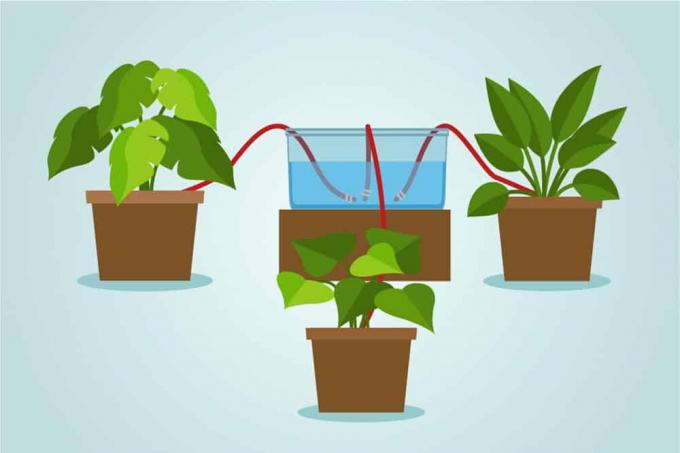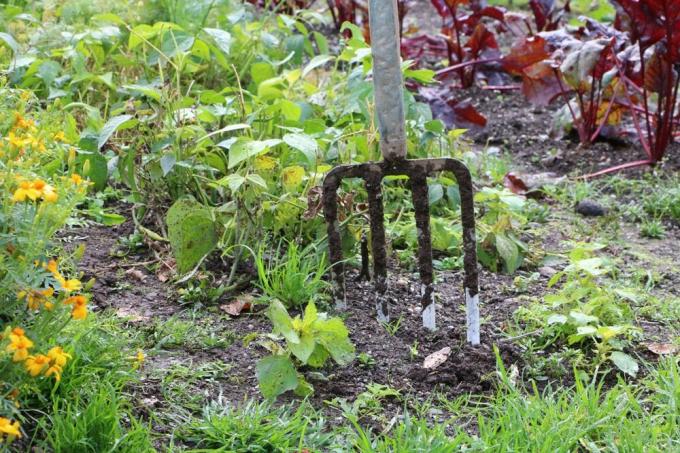

Table of contents
- Plants need water all the time
- What to do when you are absent
- The necessary utensils
- The optimal location for this type of irrigation
- The size of the water tank
- The appropriate cord
- The right time to build
- Assembly instructions step by step
- Learn from experience
If you travel, you cannot take your plants with you. So that they do not die in their absence, they must continue to be adequately supplied, especially with water. But what to do if you don't have anyone who can do the watering? Don't worry, the flowers don't have to die of thirst: a bucket of water and a few threads of wool are enough and the watering works like clockwork.
Plants need water all the time
Just like humans, flowers need regular water to thrive. If they lack the wet element for several days, they quickly drop their leaves. If the dry period lasts even longer, they can be seriously damaged or even die.
- Plants must always be sufficiently supplied with water
- the demand is higher on warm days
- Watering breaks must not last too long
- Water requirements and watering intervals also depend on the plant variety
- if you are absent, the supply must be ensured
What to do when you are absent
If you want to see your flowers safely again after a long journey, you shouldn't completely stop the water supply during your absence. Unfortunately, “pre-pouring” isn’t ideal either. If the cachepots are filled to the brim with water, a nasty surprise can follow. Most plants don't like wet roots. They're starting to rot. Therefore, a constant water supply must be ensured during a longer absence. The actual requirement can vary from plant to plant. Current weather conditions can also influence water requirements. It would certainly be ideal if someone you knew gave you access. If this is not possible, a suitable, "automatic" watering method must be found in good time.
The necessary utensils
What is needed for watering with a wool thread is usually already available in every household. If not, it can be obtained from a shop for a few euros. You need:
- a big bucket
- a thick strand of wool per plant
- two nuts (for screws) per thread of wool
- a crate or similar to raise the bucket
Tip:
The water tank should rather be more generous. It is better if there is still water left in it at the end, rather than the plants running out of water in the middle.
The optimal location for this type of irrigation

Our flowers are usually not all close together. Rather, they are mostly scattered within the living quarters. For watering, it is therefore important to consider whether all the plants in one location should be moved together are to be installed, or a separate irrigation system is to be set up on site for each plant should. The second approach is quite possible, albeit more labor intensive. It makes much more sense to place the plants close together. The choice of location is also of crucial importance:
- Light conditions should be sufficient for all plants
- sun-loving flowers should be closer to the window
- other plants further away
- The room must not be too sunny, because then the water requirement increases
- cool but bright room is optimal
Tip:
This watering method is also conditionally suitable for use on the balcony. However, if it gets a lot of sun, the plants should be brought in or watered using another method.
The size of the water tank
The size of the water container is crucial with this method. After all, the plants should be supplied with enough water until the last day of absence. The size of the water tank depends on the following factors:
- Number of plants to be supplied from it
- Water requirements of the different types of flowers
- duration of absence
- the prevailing temperature at the location (also weather-related)
Cacti, for example, require less water than petunias. The water requirement is also higher on hot summer days than in winter. For a single plant, a jam jar will certainly suffice for a few days. For longer absences and for several plants, a large 5 liter bucket is necessary, maybe even several. Since not all factors are precisely known in advance, the water requirement cannot be calculated with milliliter precision. In any case, the container should be generously dimensioned to be on the safe side.
A notice:
The water container should also not be in the sun, otherwise too much water would evaporate from the bucket due to the heat.
The appropriate cord
Not every thread is suitable for this type of watering. He must meet the following requirements:
- the material must be able to absorb water well
- it must be sufficiently thick
- the length has to be right
A thread made of real wool is ideal. Cotton or nylon are also suitable. If the thread is thin, it is twisted beforehand. Several strands of wool can also be braided into a thick braid.
The right time to build

The watering system with the wool thread can be set up quickly and easily. Depending on the number of flowers to be cared for, it can be completed within a few minutes. It is therefore perfectly sufficient to start the day before the trip or immediately before. Of course, all the necessary utensils must then be available and, if necessary, procured beforehand.
Tip:
If you still have some time until your vacation and have not yet tried this watering method, you can risk a test with a plant. If this is successfully mastered, you can later travel with a calm feeling.
Assembly instructions step by step
In order for the irrigation to work really smoothly, every detail of the construction has to be right. The easiest way to do this is to follow the step-by-step instructions below:
- Water your flowers until they are well moistened. Very dry soil would suck too much water out of the bucket right at the start. It could then be that there is not enough water available for the remaining period.
- Find a suitable location for the plants. It should be bright but not too sunny and have enough space for all plants.
- Bring all plants to the chosen place. The flowers should be close together but not touching if possible.
- Place a sufficiently large container near the flowers. He must stand elevated, approx. 10 cm above the pots of the plants. If necessary, place it on a box or similar. ä.
- Cut threads of appropriate length. If needed, braid these into thicker braids so they can hold water better.
- Attach two nuts to one end of the thread, which will add weight to the thread. This way the thread stays in the water and doesn't float to the top.
- Place the weighted end of the thread in the bucket, it must reach the bottom.
- Insert the other thread end approx. 8 cm deep in the potting soil, close to the roots.
- Fill the container with water. If necessary, some liquid fertilizer can also be added.
Tip:
Be careful not to let the strands get too sunny. Then the threads could dry out completely before the water reaches the flower.
Learn from experience
With every method that you try for the first time, you are still unsure at the beginning. Especially when it comes to how much water should be set up, you can learn a lot from experience. The amount left in the water container after the trip is a good indication of this. The condition of the plants also allows conclusions to be drawn as to whether the type and strength of the thread was a good decision. In this way, the irrigation system can be further optimized for the next upcoming absence.
 garden editorial
garden editorial I write about everything that interests me in my garden.
Learn more about irrigation

Build Ollas for irrigation yourself | DIY irrigation system
Neither the time nor the desire to keep raising the watering can? "Automatic" watering with Ollas is a great solution - at least for smaller bed areas. With DIY, this watering system is even affordable for everyone.

Test: what can solar irrigation systems do?
Solar energy for irrigation is an interesting alternative for many gardeners and plant lovers, as electricity costs can be saved in the long term. Our test should help you to decide. We will tell you how solar irrigation systems perform in comparison.

Drip irrigation - make drip hose yourself
Drip irrigation is undoubtedly the most convenient and efficient form of garden watering. It also saves a lot on water charges. The core element is a drip hose that releases the water. How you can build it yourself and what is important is here.

Build automatic irrigation yourself irrigation system
Plants need water and they need it regularly. There are various watering systems to give your plants the water they need during a short vacation.

Build your own lettuce tree Tips for the salad tube
If you only have little space, you will quickly reach your limits when it comes to self-sufficiency. Creative solutions, such as the lettuce tree, promise a remedy. We explain how vertical lettuce cultivation succeeds and reveal helpful and useful information about self-cultivation.

Watering system for potted plants: flower pot watering
Summer time is vacation time. But how do you water the potted plants in the apartment and on the balcony when you're away? The easiest way to do this is with an automatic irrigation system. You can buy it ready made or build it yourself. More about this is here.

